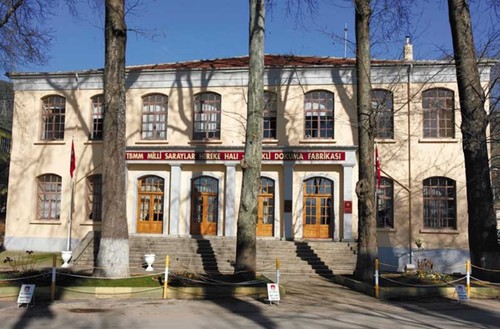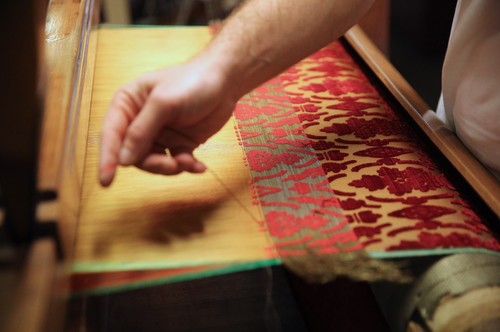© Turkuvaz Haberleşme ve Yayıncılık 2025
The Grand National Assembly of Turkey (TBMM) National Palaces Hereke Carpet and Silk Weaving Factory, has been serving as a "museum factory," while producing silk furnishings for palaces, pavilions and mansions for 176 years.

The Hereke weaving factory, one of the most important elements of courtly life in the last century of the Ottoman Empire, was founded in 1843 under the name Hereke Imperial Factory (Hereke Fabrika-i Hümayunu) during the reign of Sultan Abdülmecid to reinvigorate the art of weaving.
Starting operations to meet the need for upholstery and drapery for palaces, the factory began carpet weaving in 1891. As part of the production, which started under the direction of masters brought from Sivas province, Ladik district and Manisa province under the auspices of Sultan Abdulhamid II, these master craftsmen first weaved pattern samples given to them by the palace. Later, these designs were developed and the original Hereke style was revealed. Thus, carpet weaving units were added to the Hereke weaving factory, which had been producing silk upholstery and drapery for palaces, laying the foundation of the world-renowned Hereke carpet industry.

The most outstanding products of the factory were used to decorate palaces, pavilions and mansions, showcasing Ottoman industry, as well as in European palaces as gifts to members of foreign dynasties. The factory became a world-renowned brand half a century after its inception and won awards in international exhibitions in Paris, London, Vienna, Lyon, Brussels and Turin. Hereke is also the factory that weaved the largest carpet in Turkey. The 468-square meter carpet, produced for the ceremonial hall in the Yıldız Şale Mansion 120 years ago, is still one of the largest carpets in the world.
In addition, the 124-square meter Hereke carpet, which adorns the floor of the Muayede (Ceremonial) Hall in Dolmabahçe Palace, where official ceremonies were held during the Ottoman period, attracts thousands of domestic and foreign tourists today.
The factory, which operated under the roof of Sümerbank during the Republican period, was merged with the Presidency of National Palaces under the Privatization Law in 1995. Currently, the factory continues production as a museum-factory and hosts joint studies conducted in cooperation with researchers of national palaces.
Quality knots, curved patterns
During an interview with Anadolu Agency (AA), TBMM National Palaces Hereke Carpet and Silk Weaving Factory's Emine Günaydın said that products produced by the factory are world famous. Emphasizing that Hereke carpets gained their original style during the reign of Abdulhamid II, Günaydın said that the high quality of its products has made Hereke a brand.
Indicating that Hereke wool carpets have 360,000 knots per square meter, Günaydın said: "These knots both improve quality and allow for making curved patterns as they are small. This allows the treatment of very fine patterns. That is why the Hereke classic style emerged. The best quality carpet in the world is the Hereke carpet. Silk carpets have 1 million to 2,250,000 knots in recent periods; however, Hereke wool carpets have the best quality and the closest texture."
More beautiful with more use
Emphasizing that Hereke carpets have their own characteristics, Günaydın continued: "Hereke carpets are known to be ageless. Their close texture and quality ensure durability. Patterns have also contributed to Hereke to becoming a world brand. The more you step on them, the more beautiful Hereke carpets become, the brighter their colors become and the more beautiful outlook they gain thanks to their texture. This is the distinctive feature of Hereke carpets. Since open knots are used in Iranian carpets, they untie themselves after a certain time and do not last long. However, the Turkish knot, called Gördes, is used in Hereke carpets. A knot shape, which we call double lacing, ensures that the carpet is of good quality and has a long life."
Indicating that a person can weave one square meter of carpet in three months, Günaydın noted that Hereke carpets require intense labor, as there are 360,000 knots per square meter.
Günaydın added that visitors coming from various countries liken weaving sounds in the factory to music.
'I can weave 22 centimeters a day'
Hasan Kahraman, a velvet fabric weaver at the factory, said that they create embossed silk velvet with a special weaving form, adding that they use the jacquard and dobby mechanical system in weaving. Indicating that velvet fabrics are used to decorate sultans' rooms, Kahraman said: "Some three to four people in the world are known to be doing this job. This is a hard job that requires attention. If you do not see the slightest mistake and keep the job going, the fabric is wasted. This is not limited to the fabric. The mistake can go as far as the rebuilding of warping. I can weave 22 centimeters a day. This is hard work."
